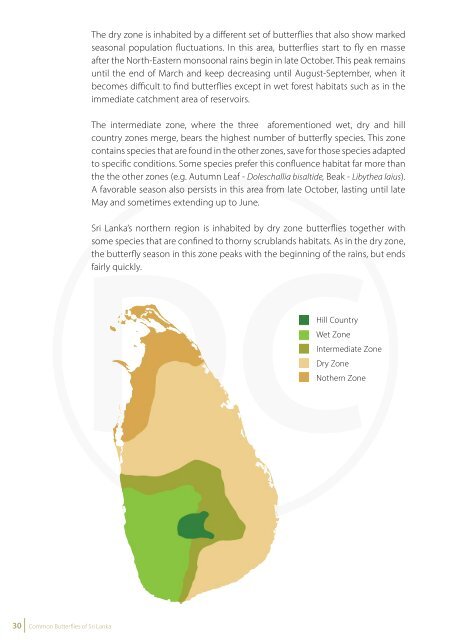Common Butterflies of Sri Lanka
Common Butterflies of Sri Lanka
Common Butterflies of Sri Lanka
You also want an ePaper? Increase the reach of your titles
YUMPU automatically turns print PDFs into web optimized ePapers that Google loves.
The dry zone is inhabited by a different set <strong>of</strong> butterflies that also show marked<br />
seasonal population fluctuations. In this area, butterflies start to fly en masse<br />
after the North-Eastern monsoonal rains begin in late October. This peak remains<br />
until the end <strong>of</strong> March and keep decreasing until August-September, when it<br />
becomes difficult to find butterflies except in wet forest habitats such as in the<br />
immediate catchment area <strong>of</strong> reservoirs.<br />
The intermediate zone, where the three aforementioned wet, dry and hill<br />
country zones merge, bears the highest number <strong>of</strong> butterfly species. This zone<br />
contains species that are found in the other zones, save for those species adapted<br />
to specific conditions. Some species prefer this confluence habitat far more than<br />
the the other zones (e.g. Autumn Leaf - Doleschallia bisaltide, Beak - Libythea laius).<br />
A favorable season also persists in this area from late October, lasting until late<br />
May and sometimes extending up to June.<br />
<strong>Sri</strong> <strong>Lanka</strong>’s northern region is inhabited by dry zone butterflies together with<br />
some species that are confined to thorny scrublands habitats. As in the dry zone,<br />
the butterfly season in this zone peaks with the beginning <strong>of</strong> the rains, but ends<br />
fairly quickly.<br />
Hill Country<br />
Wet Zone<br />
Intermediate Zone<br />
Dry Zone<br />
Nothern Zone<br />
3.3 Threats to <strong>Butterflies</strong> and their Conservation<br />
The main threat to butterflies, along with other wildlife at large, is the loss <strong>of</strong><br />
their natural habitat. While the complete destruction <strong>of</strong> a habitat is apparent<br />
to any person, habitat degradation also poses a considerable threat to small<br />
species like butterflies. These delicate butterflies require tremendously specific<br />
micro habitat conditions for their survival. Over-exposure to sunlight caused by<br />
tree felling, adjustments to the chemical composition <strong>of</strong> their feeding material<br />
due to pesticides, changes to population dynamics causes by unexpected<br />
weather conditions, and alterations to habitats caused by invasive plant species<br />
inherently influence the survival <strong>of</strong> these species.<br />
From a conservation point <strong>of</strong> view, butterflies can be divided into two categories.<br />
The most significant <strong>of</strong> these are the category <strong>of</strong> butterflies that need very<br />
specific habitat requirements in pristine forest habitats. In <strong>Sri</strong> <strong>Lanka</strong>, these<br />
habitats are consistently diminishing, and the conservation <strong>of</strong> these spaces is<br />
<strong>of</strong> prime importance. The second category <strong>of</strong> butterflies does not need such<br />
specific conditions, and these can be conserved even within human habitations<br />
through the introduction <strong>of</strong> slight adjustments to the environment.<br />
Any butterfly enthusiast can easily take part in conservation processes focused on<br />
the second category. Firstly, one could gather knowledge about the butterflies in<br />
and around ones area, both by reference and more importantly, individual field<br />
studies. These activities can help with gaining a considerable understanding<br />
<strong>of</strong> butterflies and how one’s home garden can be adapted to attract them by<br />
planting suitable larval food plants and nectar plants, and avoiding the use <strong>of</strong><br />
chemical pesticides. Through this, one can carry on learning about butterflies<br />
even at home, and will no doubt provide extraordinary satisfaction. Those who<br />
are interested in further engaging with the protection <strong>of</strong> butterflies can actively<br />
participate in conservation processes for threatened species.<br />
3.4 The Study <strong>of</strong> <strong>Butterflies</strong><br />
The most important thing one needs to study butterflies is the desire and<br />
commitment to learn about these tiny, fascinating creatures. Keen eyes and<br />
an analytical mind are necessary to further explore ones observations and<br />
environment. If a butterfly is disturbed, the chance <strong>of</strong> studying its activities is<br />
lost and any efforts at doing so will come to an end. It is important to wear dullcoloured<br />
clothing to better blend into the environment. It is also good practice<br />
to bring a note book and a pencil to the field note down any observations. This<br />
will no doubt help in analysing data collected, and in comparing field notes with<br />
published information, or even discussing observations with fellow-enthusiasts.<br />
30 <strong>Common</strong> <strong>Butterflies</strong> <strong>of</strong> <strong>Sri</strong> <strong>Lanka</strong><br />
<strong>Common</strong> <strong>Butterflies</strong> <strong>of</strong> <strong>Sri</strong> <strong>Lanka</strong> 31















